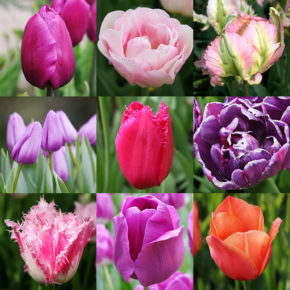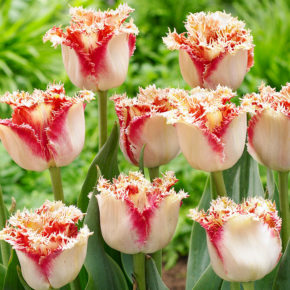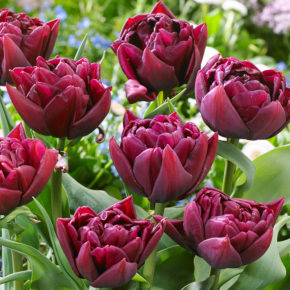Tulips are some of the most recognizable flowers in the world! In the 1600s they took the world by storm and caused the first major economic bubble in the Netherlands, known as Tulip Mania. While the initial hype over tulips caused prices to skyrocket. In the current day and age tulip bulbs are affordable to all home gardeners. The best way to celebrate the spring season is with a parade of tulips in your yard and garden! Learn how to plant tulips, when to plant tulips, and about the different types of tulips in this guide to gardening with tulips.
Guide to Gardening with Tulips
When Should Tulips be Planted?
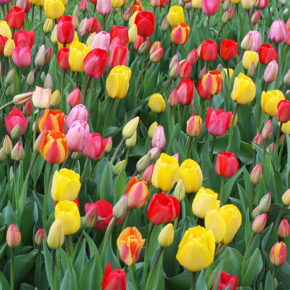 The first question you may have is when should I plant tulip bulbs? Well, this question reveals plenty of other important information for tulip planting. Plant tulip bulbs in fall when your temperatures have cooled. Tulip bulbs are for sale in retail stores near Labor Day. Online retailers Holland Bulb Farms and Tulip World begin shipping tulip bulbs in mid-September. September is the start of the tulip planting season, however, for many areas, it may be too warm to plant.
The first question you may have is when should I plant tulip bulbs? Well, this question reveals plenty of other important information for tulip planting. Plant tulip bulbs in fall when your temperatures have cooled. Tulip bulbs are for sale in retail stores near Labor Day. Online retailers Holland Bulb Farms and Tulip World begin shipping tulip bulbs in mid-September. September is the start of the tulip planting season, however, for many areas, it may be too warm to plant.
The ideal time to plant tulips is when your daytime temperatures are in the 60’s or lower on a consistent basis in fall or early winter.
Tulips originated in mountainous regions of Turkey. Due to their native climate, they require cold temperatures in order to produce a flower bud in spring. Therefore, tulips need to be planted in the fall or very early winter. By planting in the fall or early winter they will get the required amount of cold needed during the winter months. How much cold do tulip bulbs need? At least 12-16 weeks of temperatures consistently below 50 degrees during the day.
Site Selection
 When you have determined you have the temperatures needed to grow tulips and the time to plant this fall, there are a few other things to consider. Let’s start with site selection in your yard. Plant tulip bulbs in mixed perennial beds, borders, foundation plantings, rock gardens, and under trees.
When you have determined you have the temperatures needed to grow tulips and the time to plant this fall, there are a few other things to consider. Let’s start with site selection in your yard. Plant tulip bulbs in mixed perennial beds, borders, foundation plantings, rock gardens, and under trees.
Tulips require some sun to bloom. Therefore, you will want to plant them in an area that receives full to part sun. Keep in mind that planting under trees or areas that are heavily shaded in summer will be ok. The bulbs will be growing early in spring before the trees have produced leaves. Therefore, they will get more sun in spring compared to summer when they are dormant and do not need the sun to provide energy.
Healthy Tulips Begin with Healthy Soil
Once you have selected the locations you are going to plant your tulips you will want to check the soil condition in that area. Tulips are easy to grow as long as they have the correct temperatures and soil that drains well. If the soil is heavy or prone to water retention, there is a high likelihood that the bulbs will rot.
To check if your soil drains well you can do a soil percolation test. The quickest way to do this test is to dig a hole 12” deep and fill it with water. If the water takes longer than 60 minutes to drain from the hole the soil is not considered well-draining. If that is the case you will want to add soil amendments such as peat humus, compost, or plant starter mix to the soil to improve the drainage. In addition to amendments to improve drainage soil additives such as Kelp Meal can be used to increase nutrients in the soil which will lead to healthier tulips.
Tulip Classifications
When you have decided where you are going to plant your tulips based on soil drainage and sunlight you can now start to think about the type of tulips you would like to plant. There are several classifications of tulips. The classifications are based on petal size, color, height, and reliability. You should not limit yourself to one classification or type of tulip. It is best to experiment with all classifications of tulips because they all are beautiful and have something unique to offer.
Bloom Time
Bloom time refers to what time in the tulip blooming season tulips in that group will bloom. This will vary based on your location. Gardeners in warm climates will see the blooms of their tulip bulbs 2-6 weeks before gardeners in northern climates.
In addition to different climates having different bloom times, different winter and spring weather can alter bloom times. In a spring that has very cold temperatures, your bulbs and flowers will grow and bloom weeks behind when they would in a normal year. Conversely, in a warm spring, you will notice many bulbs and flowers growing and blooming weeks ahead of when they normally do.
Height
This is the average range of height for tulips. Height is impacted by growing conditions. If they are planted in the correct climate, with healthy soil and proper sunlight. they will reach their full height range.
Hardiness Zones
Tulips generally perform best in hardiness zones 3-7 as they prefer cool temperatures to grow in bloom in. Certain varieties can grow in zone 8 if temperatures are cool enough in fall and winter. For example, gardeners in Portland, OR which is zone 8 will be able to grow tulips due to their temperate climate. It is also true that tulips can be grown as annuals in hardiness zone 8-10. To grow tulips in warmer climates they need to be provided a cool period. To provide a cool period chill the bulbs for 12-16 weeks in a refrigerator. After they have been chilled, plant the bulbs at least 4-6 weeks before they start to grow in spring.
Tulip Colors
Among the various classifications of tulips, nearly every color except for blue can be found in tulips. Certain classes of tulips will bloom in a limited range of colors. Other classes of tulips provide a vast array of colors with flecks, stripes, and bi-color in the petals.
*note: Tulips grown in hardiness zones 8-10 will often require chilling prior to planting.
Key Features
This highlights the best features of each classification of tulip. While most tulips make great cut flowers some types like triumph tulips, parrot tulips, and double tulips work best. Also, some tulips perform a bit better than others in warmer climates. Therefore, gardeners in warm climates will want to use those varieties even if they are chilling the bulbs prior to planting. Since we all have a different reason for planting tulips. Also, a different eye for what is beautiful these key features can help you select which tulips to plant this fall.
Perennial Reliability
All tulips in botanical terms are considered perennial. However, some tulips behave like true perennials naturally better than others. There are cultural things that can be done to encourage your tulips to return each year. Tulips listed as excellent on the chart above have the best chance to return for several years if all planting conditions are met. Tulips that are listed as insignificant in terms of being reliably perennial are not known to return for several seasons. These tulips have a tendency to put on their biggest display of blooms the first spring after planting, and will generally not return strongly the following years.
How to Plant Tulips
When the time and temperatures are right in fall and you are ready to start planting follow a few simple guidelines for planting. First, be sure the pointed end of the bulb is facing up towards the sky. For best results and to encourage your tulips to return each year plant tulips at least 6-8″ deep. When planting you can dig a hole for each tulip and plant individually, spacing each bulb 4-6″ from the next one.
Planting Tulips in Groups
To save time and make a bigger impact tulip bulbs can be planted in groups. One way to give your tulips a fuller look is to bouquet plant them. Bouquet planting involves digger a larger hole than you would for just one bulb, and planting anywhere from 3-to-5-to-7 bulbs in that hole. If you are bouquet planting your tulips they will be spaced fairly close together, and come up like a bouquet.
Note: Emploring the bouquet method of planting may decrease the chances of your bulbs returning in a strong fashion the following spring. Since they will not have as much space to grow compared to if they were planted individually.
Mass Tulip Planting
Another way to plant tulips in a large group for mass color impact is to dig out the entire planting area. Dig out 6-8″ deep in the planting area. Place the soil you are removing from the area on a tarp or wheelbarrow for easy backfilling.
Place the tulips approximately 4-6″ from each other. Spacing will depend on how full you want the area to appear. If the bulbs tip over when placing them in the soil that is ok, they will straighten themselves out and reach for the light.
When you have the tulips placed in the planting area, you can backfill with the soil you removed. Add water to the planting area to help the soil settle and remove any air pockets. After the initial planting and watering your tulips will not require additional water from you. Tulips like to be kept dry when dormant, therefore additional water is not necessary.
Caring for Tulips
Tulips are generally carefree, but there are a few things you can do to have healthy, happy tulips! In spring when the green foliage first begins to emerge fertilize with a slow-release bulb food such as Espoma Bulb Tone or Dr. Earth Spectacular Bulb Food.
Tulips bloom for 1-2 weeks depending on the weather. When the tulips are done blooming remove the flower stems. However, you will want to keep the leaves intact until they are withered and yellow and you can easily remove the foliage from the earth. By keeping the leaves until this point you are helping to encourage new blooms for the following season. Keeping the leaves allows the bulb to gather energy from the sun for the blooms next year.
The last bit of care advice is to try and keep the bulbs dry in summer. Rain will happen and you can’t prevent that. Irrigation systems and hand watering in areas that tulips are planted can be problematic for the bulbs in future years, they prefer to be dry in summer.
I Love Tulips
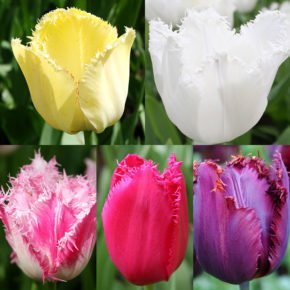 When I was 5 years old there were some tulips planted across the street from my house in the park. I didn’t realize they weren’t for public picking since I was 5, so a friend and I picked some of these large yellow and red tulips. When I brought the tulip flowers to my mom, thinking I was giving her a present, she didn’t look at it that way. She let me know they weren’t mine for the taking and explained that someone worked hard to plant those tulips. I learned my lesson but that hasn’t stopped my love for tulips.
When I was 5 years old there were some tulips planted across the street from my house in the park. I didn’t realize they weren’t for public picking since I was 5, so a friend and I picked some of these large yellow and red tulips. When I brought the tulip flowers to my mom, thinking I was giving her a present, she didn’t look at it that way. She let me know they weren’t mine for the taking and explained that someone worked hard to plant those tulips. I learned my lesson but that hasn’t stopped my love for tulips.
Tulips display some of the most diverse color patterns seen in flowers and truly bring joy to many in spring. I hope after reading this gardening with tulips guide you are compelled to plant tulips. The knowledge you have on planting and caring for them is the first step. Now for the fun part which is shopping for all the different types of tulip varieties, you can play around with. Have fun in the garden this fall and reap the rewards next spring!


